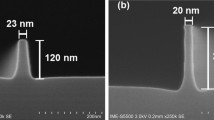Abstract
FinFET do** via implantation at room temperature could result in Fin damage within the Fin body and degrade Fin device performance. Heated implantation techniques are developed on Thermion® VIISta platform implanters to address the detrimental effects on devices caused by the damage, such as LDD formation. For well formation, there are two implant-based approaches: (1) using implant through Fin scheme, the implant damage can result in Fin damage especially for scaled Fin technology with elevated well implant dose required to suppress sub-fin leakage; (2) using the implant/epi scheme, the residual damage before epi process could result in Fin crystal defects and therefore be detrimental to device performance. In this paper, the heated implantation technique was applied to typical well formation conditions. Post heated implant wafers were characterized with TW damage, Rs for activation, and SIMS for profile response at various implant temperatures for boron (B), phosphorus (P), and arsenic (As). TCAD simulations are explored to understand the Fin well requirement to suppress sub-Fin leakage with evolved Fin technologies. For implant/Epi scheme, TCAD simulations predict the damage control required for multiple well/punch-through implants. Experimental studies showed damage-free epi growth with elevated implant temperatures.




Similar content being viewed by others
Data availability
Data discussed were normalized based on contents for relative comparison.
References
M. Togo, Y. Sasaki, G. Zschätzsch et al., Heated implantation with amorphous carbon CMOS mask for scaled FinFETs, in 2013 Symposium on VLSI Technology Dig., T14–2.
L.C. Pipes, L. McGill, A. Jahagirdar et al., NMOS source-drain extension ion implantation into heated substrates, in IIT 2014 (2014), pp. 37–42. https://doi.org/10.1109/IIT.2014.6939768
T.Y. Wen, C.I. Li, M.S. Hsieh et al., FinFET IO Device Performance Gain with Heated Implantation, in IIT2018 (2018), pp. 106–109. https://doi.org/10.1109/IIT.2018.8807924
C.L. Yang, C.I. Li, G.P. Lin, et al., Optimizing state-of-the-art 28nm Core/SRAM device performance by cryo-implantation technology, in VLSI-TSA 2012, T44. (2012) https://doi.org/10.1109/VLSI-TSA.2012.6210167
Y.R. Yang, N. BReil, C.Y. Yang, et al., Ultra low p-type SiGe contact resistance FinFETs with Ti silicide liner using cryogenic contact implantation amorphization and solid-phase epitaxial regrowth (SPER), in VLSI 2016, T7.5 (2016). https://doi.org/10.1109/VLSIT.2016.7573384
B.N. Guo, N. Variam, U. Jeong et al., Channeling do** profiles studies for small incident angle implantation into silicon wafers. AIP Conf. Proc. 680, 658–661 (2003). https://doi.org/10.1063/1.1619801
B.N. Guo, H.-J. Gossman, T. Toh et al., Abnormal angle response curves of TW/Rs for near zero tilt and high tilt channeling implants. AIP Conf. Proc. 1496, 119–122 (2012). https://doi.org/10.1063/1.4766504
B. Ye, H. Zhu, L. Chen et al., Suppression of stress-induced defects in FinFET by implantation and STI co-optimization. IEEE Trans. Electron Device 69(5), 2587–2589 (2021). https://doi.org/10.1109/TED.2021.3068241
Synopsys Sentaurus TCAD Suite, Version 2021.06.
Author information
Authors and Affiliations
Corresponding author
Ethics declarations
Conflict of interest
On behalf of all authors, the corresponding author states that there is no conflict of interest.
Additional information
Publisher's Note
Springer Nature remains neutral with regard to jurisdictional claims in published maps and institutional affiliations.
Supplementary Information
Below is the link to the electronic supplementary material.
Rights and permissions
Springer Nature or its licensor (e.g. a society or other partner) holds exclusive rights to this article under a publishing agreement with the author(s) or other rightsholder(s); author self-archiving of the accepted manuscript version of this article is solely governed by the terms of such publishing agreement and applicable law.
About this article
Cite this article
Guo, B.N., Pradhan, N., Zhang, Y. et al. The scaled FinFET well formation using heated implantation. MRS Advances 7, 1468–1471 (2022). https://doi.org/10.1557/s43580-022-00413-0
Received:
Accepted:
Published:
Issue Date:
DOI: https://doi.org/10.1557/s43580-022-00413-0




